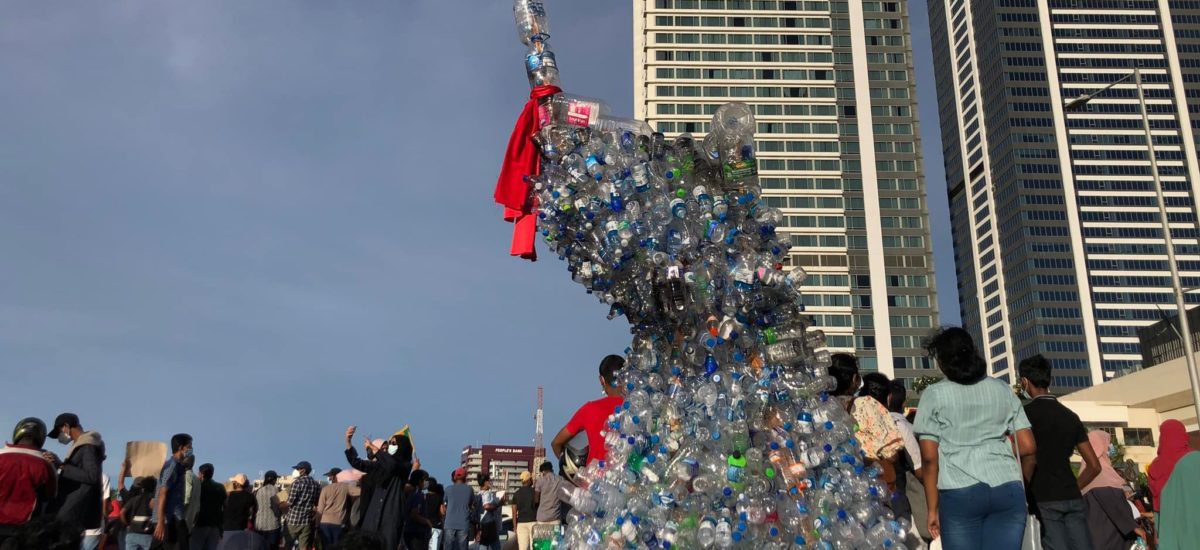Photo courtesy of The Pearl Protectors
Today is International Mother Earth Day
The last two years have witnessed the unparalleled destruction of Sri Lanka’s environment, with more than 1,000 cases of environmental degradation being reported throughout the country. The plundering of natural resources by elected public officials and their cronies is one of the first reasons that took citizens out on the streets to fight against the wanton destruction. Fuelled by shortages of basic necessities and accounts of rampant corruption, later protests exploded into a full blown campaign demanding the resignation of the president and his entire government.
By consistently appointing completely unsuitable people to positions of responsibility, President Gotabaya Rajapaksa is directly responsible for allowing the 1,000 cases to take place with impunity; being a government politician or a henchman gave people the right to grab whatever they wanted to make as much money as possible with scant regard for the damage being done; damage that would last for generations to come.
“This is the government that has done the most damage ever to the environment. Environmental destruction is one of the main factors contributing to the failure of the government,” said Jayantha Wijesingha, founder of Rainforest Protectors. “Every kind of ecosystem has been destroyed. Water has been polluted, air pollution has increased and temperatures have risen because of deforestation. Appointed officials are not acting in a manner worthy of their posts,” Mr. Wijesingha pointed out.
Today the country is feeling the effects of myopic and unsustainable protects undertaken for the benefit of politicians and their friends, with the end result being the bankruptcy of the entire nation.
Several environmental organisations including Rainforest Protectors, the Environmental Foundation and the Wildlife and Nature Protection Society joined up to fight the government’s ill-advised and corrupt policies and actions.
“We want to stop the environmental crimes. When you destroy the environment, the consequences are severe. We have had to fight this government throughout with major protests and several small protests,” said Mr. Wijesingha. “We took to the streets to ensure that people knew this government was not sensitive to the environment and to make known the destruction that was taking place.”
On April 13, environmentalists joined the Galle Face protests. At the site, discussions were held on how the government has been destroying the environment and why it should step down. The area was kept clean despite the many thousands of people there each day. To minimise plastic pollution, people were asked to refill their water bottles at a special tent. There were educational talks on how to keep the environment clean with displays of material such as posters, placards and slogans. Social media was used to convey the message that the conservation community was part and parcel of the people’s fight.
At Gotagogama, a painting was completed on the environmental destruction that had happened during the current government. A mural made of over 2,000 plastic bottles depicting a fist with a middle finger was erected symbolizing the protest against the government. People used plastic bottles to replicate the slogan Go Home Gota on the Port City fence.
The wholesale destruction of the environment began with a controversial road through the Sinharaja forest, a World Heritage Site, on the pretext of joining two villages without carrying out the necessary Environmental Impact Assessment. President Rajapaksa himself visited the site and proclaimed that the people wanted it. Environmentalists were agreeable to tar the road but not to widen it. A campaign was launched and the widening was halted.
After the saga of the Sinharaja road came many other transgressions. Permits to transport sand and gravel were discontinued, resulting in the sand mafia mining vast quantities that caused the degradation of riverine systems. Two circulars protecting other state forests were withdrawn, leading to the takeover of forest land by big business to cultivate crops on a large scale ignoring the plight of small farmers and generating profits that were sent overseas. Some 62,0000 acres have been given to a Singaporean company for sugar cane cultivation.
Other roads were built through sensitive areas such as the Knuckles without proper assessment for damage. Land was taken for commercial expansion of sugar cane plantations in Haputale, Bibile and Wellawaya. Some 100,000 acres given for aloe vera development in Rajanganiya and more land for corn cultivation in Mahaveli reserve areas. Land Reform Commission land was taken by political henchmen and businessmen without getting proper permits through illicit transactions. Cultivation was allowed in areas such as Yala and other protected areas. Pradeshiya Sabha chairmen from the ruling party were responsible for garbage dumping in wetlands and forest areas. In the Muthurajawala wetlands, land was encroached upon and filled up by government cronies.
In Mount Lavinia, millions of dollars was spent on an unnecessary coastal development project without proper approval or studies. In the power sector, renewable energy projects were delayed or not implemented because the power sector mafia controlled Ceylon Electricity Board. The government developed mini hydro projects that were not operational during droughts. Unnecessary road development and jogging paths have destroyed sensitive ecosystems and reservations of water bodies and bird parks in areas such as Madiwela and Beddegana.
The Human-Elephant conflict worsened with several elephant deaths as humans encroached on to their habitats. Digging trenches benefitted the sand mafia but the elephants fell in and could not get out. Elephant were kept in restricted areas without proper food or water to starve to death. Wildlife officials were unable to do their jobs due to political interference. It is a never ending list.


